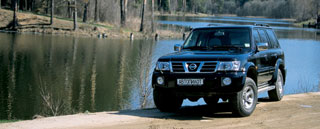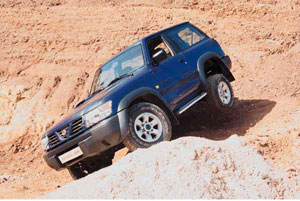Test Drive Nissan Patrol LWB 1998 - 2004 SUV
Solaris
 Since then, Bush's legs finally brought domestic agriculture to themselves, and the tractor drivers remained only in the cinema, the word diesel is associated with many exclusively with clothing. And in vain.
Since then, Bush's legs finally brought domestic agriculture to themselves, and the tractor drivers remained only in the cinema, the word diesel is associated with many exclusively with clothing. And in vain. I bet that the image of the intelligent engineer Rudolph Diesel, which invented the new principle of operation of the internal combustion engine at the end of the XIX century, should not be before your eyes. Most likely, the deadly drunk tractor driver floats from the memories in the impregnated smelly diesel engineer. Or a trucker, touching the Size frosty morning under his masseer with a soldering lamp in his hands. From these associations and has grown persistent idiosyncracy of Russian car owners to diesel engines.
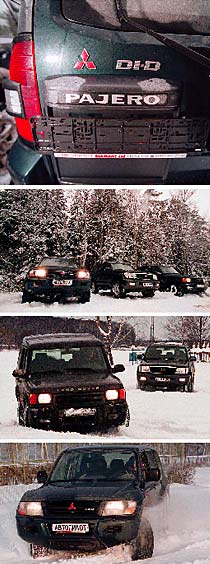 Short course of physics. In fact, diesel, especially modern, in its design and appearance does not differ from the usual gasoline. It uses the same nodes and the same geometry. But all parts that are subjected to loads during operation are reinforced, because the degree of compression in diesel engines is two to three times higher than that of gasoline engines.
Short course of physics. In fact, diesel, especially modern, in its design and appearance does not differ from the usual gasoline. It uses the same nodes and the same geometry. But all parts that are subjected to loads during operation are reinforced, because the degree of compression in diesel engines is two to three times higher than that of gasoline engines. This is due to a fundamentally different scheme for the formation of the fuel mixture and its burning. In most gasoline engines, gasoline pairs are first mixed with air in the inlet system (carburetor or injector). This cocktail enters the cylinders, where the ignition candle is flammable.
In the diesel engine in the cylinder comes simply air. When, during the compression process, it is heated to the temperature of self-ignition fuel (about 800C), then the fuel is supplied to the cylinder, which explodes, and the process went, the car went. Such is the primitive scheme of the simplest diesel engine.
Green exhaust. The primitive motor operating on the diesel fuel really resembles a compressor for road works, causing a feeling of a squeamish disgust. And no one will install such an engine in a solid car worth a few tens of thousands of dollars.
But since Rudolf Diesel, science has known not one trick, and most automakers install diesel motors almost all their own models. Moreover, in Europe now there is a real diesel boom - first of all due to the fact that diesel fuel is cheaper than high-octane gasoline, and on the same amount of kilometers covered, there is a smaller amount. Hence the high efficiency of motors, it is first. Secondly, despite the color of the exhaust - sometimes the black smoke cloud breaks out of the pipe - when working on a poor mixture in black smoke, it contains a much less carbon monoxide. It turns out that diesel is more environmentally friendly. And finally, the most importantly - diesel engines have a high torque in different ranges of the rotational speed of the crankshaft. It is ideal for working in heavy road or roads-free conditions. So, it is most interestingly installed on jeeps.
Based on this, the autopilot decided to just ride. And necessarily on SUVs, of course, the most popular in our country. Prestigious. Well acquaintances to our readers and therefore do not require repeat from us in the description of the comfort of the cabin and numerous off-road addicts. We were interested in other - dynamics and noise. All models are diesel.
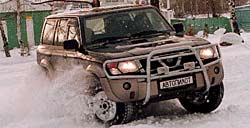 Under a quiet growl. We paid special attention to the noise level in the salon - these four vehicles are equipped with the most modern engines with direct fuel injection, what is called Direct Injection. Hence, by the way, DI-D abbreviations on Pajero and Di on Patrol. The main difference between such motors from classic diesel engines - in the design of the combustion chamber.
Under a quiet growl. We paid special attention to the noise level in the salon - these four vehicles are equipped with the most modern engines with direct fuel injection, what is called Direct Injection. Hence, by the way, DI-D abbreviations on Pajero and Di on Patrol. The main difference between such motors from classic diesel engines - in the design of the combustion chamber. The direct injection means that the fuel is fed directly to the engine cylinders, in a small space above the piston, and the combustion chamber is turned out in the body of the piston. Hence the name is unrequited. A classic diesel is equipped with a separate vortex combustion chamber associated with a cylinder by a narrow canal. Flying through it, the air is intensively spinning and mixed well with fuel. With this scheme, the level of detonation and noise is significantly less than on a direct injection motor. Actually, such diesel engines were more used to install on passenger cars. It seems from good well looking for, but the immediate injection is more progressive in terms of fuel economy, increasing the capacity and reduce the level of exhaust toxicity.
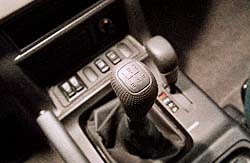 Contemporary electronic control of high-pressure pumps (TNVD), which pump the diesel fuel in the combustion chamber, the use of a multiclapped inlet / release system and other new technologies made it possible to use Direct Injection on relatively compact motors. Each company came to this its own way, but the essence is one - electronic control of the amount of injected fuel, an increase in the intake pressure, which has allowed to achieve the effect of the vortex chamber. Land Rover engineers applied even individual pumps on the nozzles of each cylinder, abandoning the TNVD.
Contemporary electronic control of high-pressure pumps (TNVD), which pump the diesel fuel in the combustion chamber, the use of a multiclapped inlet / release system and other new technologies made it possible to use Direct Injection on relatively compact motors. Each company came to this its own way, but the essence is one - electronic control of the amount of injected fuel, an increase in the intake pressure, which has allowed to achieve the effect of the vortex chamber. Land Rover engineers applied even individual pumps on the nozzles of each cylinder, abandoning the TNVD. The power of all four engines is increased by pressing. Unlike gasoline engines here, it works almost at any frequency of operation of the engine - the exhaust gases rotate, and the degree of compression in the diesel engine, we will remind much higher. And Mitsubishi and Nissan have the highest degree of engines forcing - the turbocharger is also supplied with an intermediate air cooling radiator - intercooler.
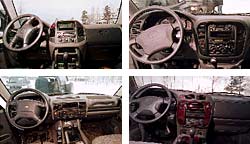 Under friendly rye. All four cars are rather quiet inside. With gasoline versions of them, of course, do not compare, but when the magnetol turned on, the skidding sound of a diesel engine almost does not cut the ear. At idle, especially on a heated engine, he even resembles the morning grumbling and good dog.
Under friendly rye. All four cars are rather quiet inside. With gasoline versions of them, of course, do not compare, but when the magnetol turned on, the skidding sound of a diesel engine almost does not cut the ear. At idle, especially on a heated engine, he even resembles the morning grumbling and good dog. Noise begins to actively penetrate the salon only when the turnover rolls the mark of 4 thousand revolutions. As a rule, this happens at the moment of a sharp set of speed on the motorway or when the engine works in the intense mode. This is when low transmission is enabled, all locks, and you are trying to get out of deep, sorry, pits. In the first case, you can make a romance radio, in the second one - no one pays attention to the process of jeeping.
My subjective opinion is the leader in noise insulation Toyota Land Cruiser. The second place was divided by Nissan Patrol and Land Rover Discovery. Mitsubishi Pajero - on the first time.
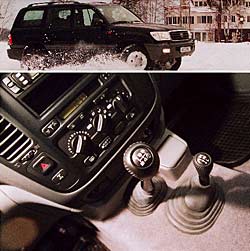 The dynamics of all four cars were at a decent level, and Mitsubishi Pajero in this nomination confidently broke out first. This is the only car that instantly responds to pressing the gas pedal - almost like a gasoline version. Advertising slogan Feel the difference in this case is inappropriate. Even if you compare passport data on overclocking up to hundreds and maximum speed, then the diesel version is inferior to gasoline just a couple of seconds kilometers.
The dynamics of all four cars were at a decent level, and Mitsubishi Pajero in this nomination confidently broke out first. This is the only car that instantly responds to pressing the gas pedal - almost like a gasoline version. Advertising slogan Feel the difference in this case is inappropriate. Even if you compare passport data on overclocking up to hundreds and maximum speed, then the diesel version is inferior to gasoline just a couple of seconds kilometers. The difference between the remaining three participants of our test was insignificant. All of them are very quickly promoted to maximum revolutions and are quite quickly gaining laid in the city 60 km / h, only a little behind Pajero on the track. And they all differ in amazing elasticity on increased gears; Other cars overtake on the track - just one pleasure. With the fourth gear on, it is quite possible to slow down to 40--60 km / h, after which it is confidently accelerated back to hundreds.
Frankly pleased the behavior of Toyota and Nissan on a straight, fifth gear. When moving at a speed of 110--120 km / h under the gas pedal, there is still a completely decent stroke. And this is not a fiction - with a sharp press on the jeep pedal easily accelerate from 120 to passports 170 km / h in just a few seconds.
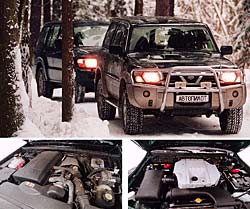 To appreciate the charm of diesel jeeps on off-road, we practically did not have to do - for several reasons. First, three cars of the four were shods in unsuitable for such a case of rubber. Secondly, the task was not stood. This time we wanted to evaluate the operational qualities of diesel engines in normal, and not in a combat atmosphere. And we will deal with jeep some other times and necessarily take with you to compare gasoline analogue. On off-road rubber.
To appreciate the charm of diesel jeeps on off-road, we practically did not have to do - for several reasons. First, three cars of the four were shods in unsuitable for such a case of rubber. Secondly, the task was not stood. This time we wanted to evaluate the operational qualities of diesel engines in normal, and not in a combat atmosphere. And we will deal with jeep some other times and necessarily take with you to compare gasoline analogue. On off-road rubber. This time we allowed ourselves only to ride a snow virgin. But for a diesel engine is not a test, but a children's game. We connect a four-wheel drive, put the second reduced and forward - the gas pedal can not be touched. Under the silent growl diesel crawl itself. Try to repeat on gasoline.
I am a capricious is minus. The main argument of opponents of a diesel engine is difficult to run in frosts, despite the system of preheating, which is equipped with all modern cars. In the combustion chambers, incandescent candles are inserted, which, after turning on the ignition, are heated to 800 - 900C, after which the engine is ready for launch. The power supply after that is automatically removed. In summer, the warming light of the warm-up goes out after 3--5 seconds., In winter, this process can occupy all 20. We encountered this fairly early in the morning on the day of the test race to the Large Volga region. During the night, the temperature fell to -21s, although in the evening there was wet and dirty on the street. But all the cars are new, and therefore they started out absolutely no problem.
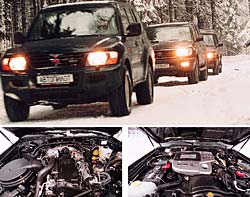 Ha, tells the stubborn fan of gasoline engines, new things are well. Let's see how the old engine will behave. Yes, and the incandescent candle battery can suck in just a few weeks of stable frost.
Ha, tells the stubborn fan of gasoline engines, new things are well. Let's see how the old engine will behave. Yes, and the incandescent candle battery can suck in just a few weeks of stable frost. We were convinced that such a skepticism in relation to modern dieselms is not applicable. First, all four jeeps installed two batteries, which increases the reliability of the entire system. They are connected through a special relay and work on a discharge in turn, as they charge. By the way, on gasoline engines no one will give a lifelong warranty on the battery. Well, a maximum of two years.
Moreover, manufacturers have taken into account another annoying factor that overshadows the life of Russian tractor drivers - the poor quality of diesel fuel. Due to the increased content of paraffin in it in a strong frost, the fuel is thick, scores the fuel line, and diesel stalls, after launching a minute-other. A trucker comes with a soldering lamp in the position of a man from below. But we are not on the masse - in Nissan Patrol, Mitsubishi Pajero and Toyota Land Cruiser found a key to enable the warm-up system of the entire fuel line. In Land Rover, such a system is installed on request. In the struggle for survival in harsh conditions, the system can play a decisive role - thank God, we did not have to use it.
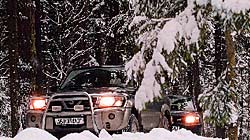 But cheap is plus. Returning to the editor, we poured with frost for a hundred grams and took the calculator. The cost of the domestic diesel fuel is in Moscow an average of 7.3 rubles. Owners of gasoline versions prefer to refuel 95th (9 rubles. 30 kopecks), although all jeeps may well ride at 92nd. The average exhaustion consumption per 100 km in the city is 12 liters, gasoline - ranges between 17 and 23 l depending on the model (on average - 20 l). According to the most approximate estimates, the savings are 8 liters or about 100 rubles per hundred kilometers traveled. The average monthly mileage is 1500 km - saving 1.5 thousand rubles. Per year - 18 thousand per minimum. For a person ready to lay out from 30
But cheap is plus. Returning to the editor, we poured with frost for a hundred grams and took the calculator. The cost of the domestic diesel fuel is in Moscow an average of 7.3 rubles. Owners of gasoline versions prefer to refuel 95th (9 rubles. 30 kopecks), although all jeeps may well ride at 92nd. The average exhaustion consumption per 100 km in the city is 12 liters, gasoline - ranges between 17 and 23 l depending on the model (on average - 20 l). According to the most approximate estimates, the savings are 8 liters or about 100 rubles per hundred kilometers traveled. The average monthly mileage is 1500 km - saving 1.5 thousand rubles. Per year - 18 thousand per minimum. For a person ready to lay out from 30 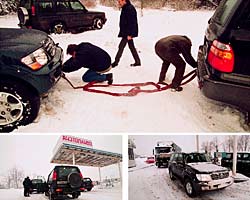 up to 50 thousand per car, it is not so big numbers, but still nice.
up to 50 thousand per car, it is not so big numbers, but still nice. And here is another very important plus. The further we drove away from Moscow along the Dmitrovskoye highway towards the Volga, the less we met a gas station. And at the stations themselves, AI-95 signs were increasingly replaced by signs of diesel fuel. The depthion still lives on the needs of tractor drivers and truckers. The situation is not critical as ten years ago, but refueling on the dieselle much easier. And not even 7.20, but significantly cheaper. Pollytra still remains a universal payment facility in our country.
Well, for diesel!
Text Nikolai Kachurin, photo Dmitry Azarov
A source: "Autopilot"








